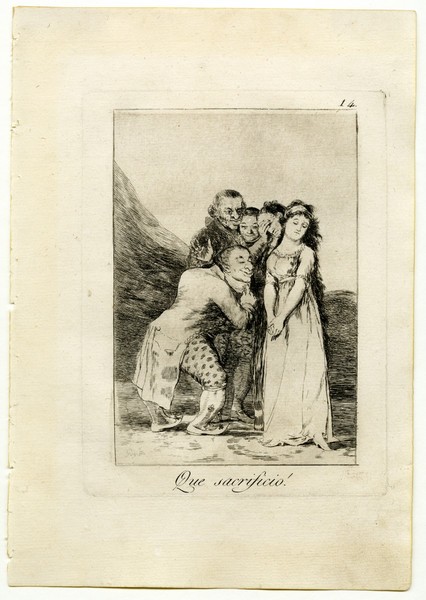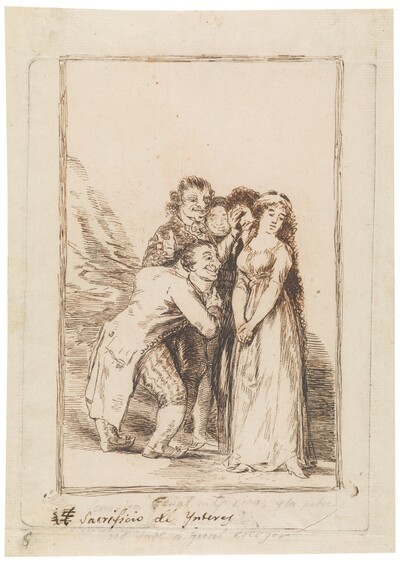- Cronología
- Ca. 1797 - 1799
- Dimensiones
- 203 x 152 mm
- Técnica y soporte
- Etching, burnished aquatint and drypoint
- Reconocimiento de la autoría de Goya
- Undisputed work
- Ficha: realización/revisión
- 24 Nov 2010 / 29 May 2024
- Inventario
- 225
What a sacrifice (bottom)
14. (in the upper right-hand corner)
Goya (in the upper left-hand corner)
See Francisco de Goya y Lucientes, Painter.
There is a state proof before the letter, which is in the National Library, with a different legend that readsYou love me, I love you, give me your finger.
The preparatory drawing for this engraving is in the Prado Museum in Madrid.
A young woman with long hair has a look of disgust on her face. Next to her, a man gazes at her libidinously, a deformed being with bowed legs, extravagant clothes and a huge face with coarse features that make us understand the young woman's expression. Next to her, Goya has depicted an older woman, probably her mother, holding her hand to her head in mock emotion. Somewhat further back, he places two other men who could be the girl's father and the priest who is to celebrate the marriage between the girl and her future husband.
The manuscript in the Prado's National Museum notes: "As it must be! The bridegroom is not the most desirable, but he is rich and at the cost of an unhappy girl's freedom he buys the support of a starving family. Such is the way of the world". In the Ayala manuscript, this print is marked "Idem anterior". Finally, the manuscript in the National Library comments that "vile interest obliges parents to sacrifice a young and beautiful daughter by marrying her off to an old hunchback, and there is no lack of a priest to sponsor such marriages".
The theme of marriages for interest is addressed on several occasions in the series of Los Caprichos, in which Goya reflects on the marriages arranged by parents with wealthy husbands who, in the end, sacrificed their daughters' youth and beauty. The Caprice no. 14 should be related to the works of Leandro Fernández de Moratín (Madrid, 1760-Paris, 1828) The Old Man and the Girl and The Girl's Yes in which, in the same way as the Aragonese painter does, he questioned marriages of convenience.
Goya had already dealt with this question in one of his tapestry cartoons, The Wedding, in which the way he characterises the faces of the figures is very similar to what he does in some of the prints in The Caprices.
The plate is preserved in the National Chalcography (no. 185).
-
Goya. Gemälde Zeichnungen. Graphik. TapisserienKunsthalle BaselBasle1953from January 23th to April 12th 1953cat. 206
-
Goya. Das Zeitalter der Revolucionen. Kunst um 1800 (1980 – 1981)Hamburger KunsthalleHamburg1980cat. 25
-
Goya. La década de Los CaprichosMadrid1992organized by Real Academia de Bellas Artes de San Fernando sponsored by Fundación Central Hispano, Madrid, consultant editor Nigel Glendinnig. From October 26th 1992 to January 10th 1993cat. 23
-
Francisco de GoyaMuseo d'Arte ModernaLugano1996exhibition celebrated from September 22nd to November 17th.cat. 14, p.41
-
Francisco Goya. Sein leben im spiegel der graphik. Fuendetodos 1746-1828 Bordeaux. 1746-1996Galerie KornfeldBern1996from November 21st 1996 to January 1997cat. 20
-
Francisco Goya. Capricci, follie e disastri della guerraSan Donato Milanese2000Opere grafiche della Fondazione Antonio Mazzottacat. 14, p.21
-
Goya. La imagen de la mujerMuseo Nacional del PradoMadrid2001from October 30th 2001 to February 10th 2002. Exhibitied also at the National Gallery of Art, Washington, March 10th to June 2nd 2002, consultant editor Francisco Calvo Serrallercat. 92
-
Goya e la tradizione italianaFondazione Magnani RoccaMamiano di Traversetolo (Parma)2006consultant editors Fred Licht and Simona Tosini Pizzetti. From September 9th to December 3th 2006cat. 14, p.149
-
Goya. Opera graficaPinacoteca del Castello di San GiorgioLegnano2006exhibition celebrated from December 16th 2006 to April 1st 2007p.26
-
Goya et la modernitéPinacothèque de ParisParís2013from October 11st 2013 to March 16th 2014cat. 134
-
Hamburg2019cat. 99
-
2022
-
Goya engravings and lithographs, vol. I y II.OxfordBruno Cassirer1964p.84, cat. 49
-
Vie et ouvre de Francisco de GoyaParísOffice du livre1970p.178, cat. 479
-
Goya, la década de los caprichos: dibujos y aguafuertesMadridReal Academia de Bellas Artes de San Fernando1992pp.37-39, cat. 22-23
-
Catálogo de las estampas de Goya en la Biblioteca NacionalMadridMinisterio de Educación y Cultura, Biblioteca Nacional1996p.81, cat. 102
-
El libro de los caprichos: dos siglos de interpretaciones (1799-1999). Catálogo de los dibujos, pruebas de estado, láminas de cobre y estampas de la primera ediciónMadridMuseo Nacional del Prado1999pp.116-119
-
ParísPinacoteca de París2013p. 195
-
Goya. In the Norton Simon MuseumPasadenaNorton Simon Museum2016pp. 42-75
-
HamburgHirmer2019p. 310
-
Museo de Bellas Artes de Badajoz y Diputación de Badajoz2022p. 33

